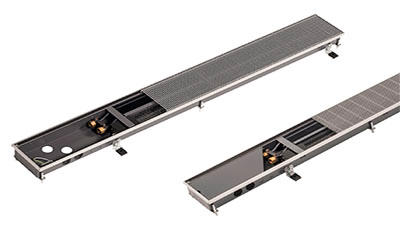Trench Technology
Katherm QL
Displacement ventilation system for draught-free ventilation.Overview
Katherm QL trench systems are synonymous with low-turbulence room ventilation. They effectively supply a space with treated, fresh air as low-turbulence displacement air.Katherm QL trench systems are synonymous with low-turbulence room ventilation. They effectively supply a space with treated, fresh air as low-turbulence displacement air.
The displacement air enters the room at a low air velocity of less than 0.3 m/s and is distributed within the room as a low-pulse, draft-free air flow for maximum comfort in the occupied zone.
Alongside the proportion of displacement air, air heated by the coil rises up the glass façade, efficiently shielding it from a drop in temperature.
Two channel widths and heights and five channel lengths each are sufficient to ensure optimum comfort with the Katherm QL in projects.
The avoidance of rotating parts keeps investment costs low. Maintenance is also very simple.
Made-to-measure products are available for architectural styles with individual geometries. This applies to the trench and grille. Mitered corners, curved designs, corners and angles, pillar recesses and a range of different grille finishes and frame edges are available. Ask us for advice.
The Eurokonus valve connection enables the Katherm QL to be quickly and easily installed on site. In addition, height adjustment feet and raised floor height adjustment feet are supplied as standard to further reduce the installation time and thus the cost.
High-output Cu/Al convectors with two convector widths 70 and 100 mm and two convector heights 50 and 100 mm.
In heating mode, a barrel of air is formed on the façade above the convector, which effectively prevents a drop in temperature on the surface of the window and supplies the room with heat. It does so at the same time meeting the most exacting demands for a comfortable air flow.
The displacement air design consists of integrated eccentric and adjustable air guide rollers, a row of perforations, and deflection plates for a uniformly directed and low-pulse displacement air discharge. Supply air spigots for air supply are arranged at the side along the length of the duct.
The treated displacement air is fed into the room at low turbulence through the large air outlets in the floor and is distributed in the room at very low air velocities.


